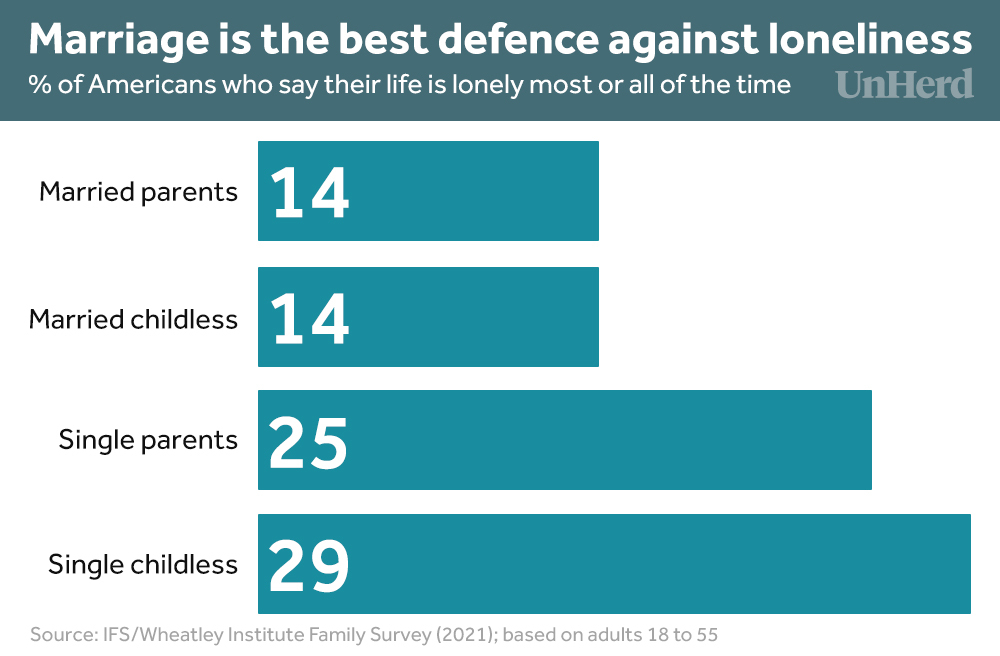This Valentine’s Day, the news is awash with stories of loneliness and atomisation among adults across the West. Though clinical attention has focused on this brewing crisis, the remedies are often misplaced.
Last year, US Surgeon General Vivek Murthy issued an advisory on this new national problem, which was exacerbated by the Covid lockdowns. Following his appointment to the position, Murthy noted growing numbers of Americans approaching him, reporting that they “felt isolated, invisible, and insignificant”. Today, Murthy claims, “about one in two adults in America [have] reported experiencing loneliness”, while the effects of social isolation on mortality are about the same as smoking 15 cigarettes a day.
This loneliness outbreak emerges from the fraying of our most fundamental social bonds — friendships, neighbourliness, church attendance, participation in charitable causes — most of which have been in decline in recent decades. All the while, social media erodes the character and quality of our in-person relationships. Murthy and other observers of our loneliness crisis acknowledge many of these causes in their diagnosis and prescriptions about what we can do to reduce loneliness in America.
But one important word is missing in the public conversation about loneliness: marriage. In the course of researching my new book, I found not only that the happiest and most financially secure Americans are married but also that the least lonely Americans are married. Meanwhile, marriage tends to matter more than many of the factors that public health leaders such as Murthy focus on.

According to analysis of a 2021 YouGov survey by the Institute for Family Studies and the Wheatley Institute, unmarried adults aged 18-55 were twice as likely to say they are lonely “most of the time” or “all the time” as married adults (28% vs.14%). The difference is still significant after controlling for education, income and other demographic factors. In fact, marital status matters more than income, race, gender, age, and education when it comes to predicting who is lonely in America.
Going off this data, marriage reduces the odds of being lonely by 48%. Having a household income of over $100,000 reduces the odds by 27%, while a college education does so by 23%. This issue is vital because the marriage rate has fallen more than 60% since 1970, to the point where 25% of 40-year-olds haven’t married, compared to just 6% in 1980. Today, the share of Americans aged 60 and older who are divorced or never married has more than doubled, up from 12% in 1970 to 25% in 2021. This number will only climb in the coming years.
Indeed, loneliness was declared a public health emergency last week in San Mateo County, California. This Bay Area county of roughly three-quarters of a million people is the fourth-richest in the United States, with a median income of just under $150,000. And yet feelings of isolation have emerged as a concern even in America’s most privileged areas.
We’ve seen this story play out in Japan, where these trends are further along. As the New York Times has observed, the “extreme isolation of elderly Japanese is so common that an entire industry has emerged around it, specialising in cleaning out apartments where decomposing remains are found”. About one in four Japanese young adults (18-34) say they have never had sex, the rates of the never-married young men and women in the island nation keep climbing, and fertility is well below replacement rate.
The United States is not yet close to reaching the family collapse unfolding in Japan. But the signs across America, including San Mateo County, are concerning. Where California goes, so America follows, as they say.
Policymakers fail to acknowledge the precipitous declines in dating, marriage, and childbearing, and the effects these have on loneliness. Murthy’s list of solutions for today’s loneliness crisis had little to say about marriage and childbearing, even though there is no group of Americans less lonely than married parents.
As we mark this romantic day, more young and middle-aged single adults would do well to date with an eye towards getting married. Those who are in good relationships should consider putting a ring on it. And for those of us who have already tied the knot, there are always new ways to deepen the tie that binds.